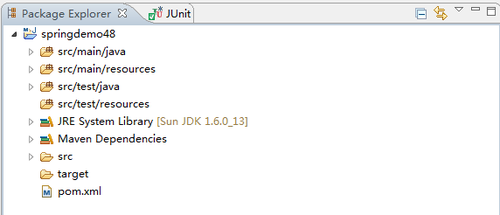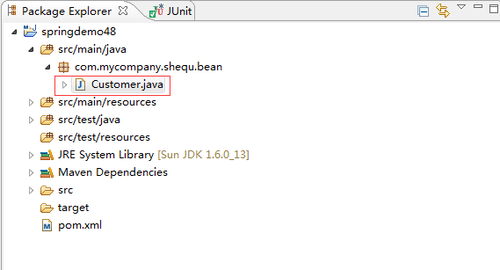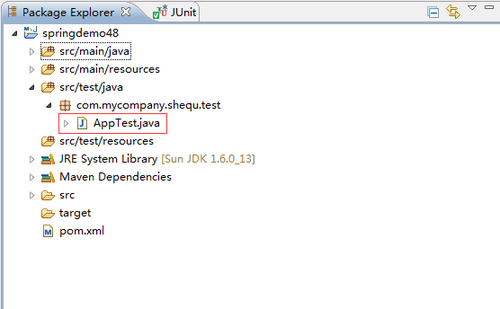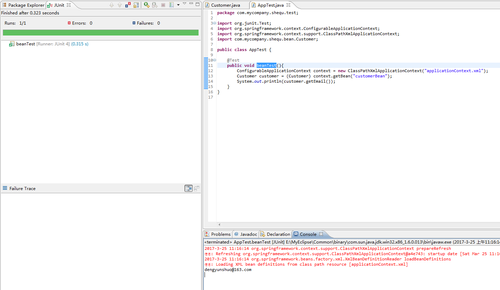首页 > 代码库 > Spring4-EL中正则表达式的使用
Spring4-EL中正则表达式的使用
1.创建Maven项目,项目名称springdemo48,如图所示

2.配置Maven,修改项目中的pom.xml文件,修改内容如下
<project xmlns="http://maven.apache.org/POM/4.0.0" xmlns:xsi="http://www.w3.org/2001/XMLSchema-instance" xsi:schemaLocation="http://maven.apache.org/POM/4.0.0 http://maven.apache.org/xsd/maven-4.0.0.xsd"> <modelVersion>1.0.0</modelVersion> <groupId>shequ</groupId> <artifactId>springdemo13</artifactId> <version>0.0.1-SNAPSHOT</version> <properties> <java.version>1.7</java.version> <project.build.sourceEncoding>UTF-8</project.build.sourceEncoding> <project.reporting.outputEncoding>UTF-8</project.reporting.outputEncoding> </properties> <repositories> <repository> <id>codelds</id> <url>https://code.lds.org/nexus/content/groups/main-repo</url> </repository> </repositories> <dependencies> <dependency> <groupId>javax.annotation</groupId> <artifactId>jsr250-api</artifactId> <version>1.0</version> </dependency> <dependency> <groupId>org.springframework</groupId> <artifactId>spring-test</artifactId> <version>4.1.4.RELEASE</version> </dependency> <dependency> <groupId>junit</groupId> <artifactId>junit</artifactId> <version>4.10</version> </dependency> <dependency> <groupId>org.springframework</groupId> <artifactId>spring-core</artifactId> <version>4.1.4.RELEASE</version> </dependency> <dependency> <groupId>org.springframework</groupId> <artifactId>spring-context</artifactId> <version>4.1.4.RELEASE</version> </dependency> <dependency> <groupId>org.springframework</groupId> <artifactId>spring-jdbc</artifactId> <version>4.1.4.RELEASE</version> </dependency> <dependency> <groupId>mysql</groupId> <artifactId>mysql-connector-java</artifactId> <version>5.1.34</version> </dependency> </dependencies> <build/> </project>
3.在src/main/java下创建实体Bean Customer,包名(com.mycompany.shequ.bean)如图所示

4.实体Bean Customer的内容如下
package com.mycompany.shequ.bean;
import org.springframework.beans.factory.annotation.Value;
import org.springframework.stereotype.Component;
@Component("customerBean")
public class Customer {
private String name;
private String email;
public String getName() {
return name;
}
public void setName(String name) {
this.name = name;
}
public String getEmail() {
return email;
}
@Value("#{(‘dengyunshuo@163.com‘ matches ‘^[_A-Za-z0-9-]+(\\.[_A-Za-z0-9-]+)" +
"*@[A-Za-z0-9]+(\\.[A-Za-z0-9]+)*(\\.[A-Za-z]{2,})$‘) ? ‘dengyunshuo@163.com‘:‘不合法‘}")
public void setEmail(String email) {
this.email = email;
}
}5.在src/main/resource下创建核心的配置文件applicationContext.xml,如图所示

6.核心的配置文件applicationContext.xml的内容如下
<beans xmlns="http://www.springframework.org/schema/beans" xmlns:xsi="http://www.w3.org/2001/XMLSchema-instance" xmlns:p="http://www.springframework.org/schema/p" xmlns:context="http://www.springframework.org/schema/context" xmlns:util="http://www.springframework.org/schema/util" xsi:schemaLocation="http://www.springframework.org/schema/beans http://www.springframework.org/schema/beans/spring-beans-4.0.xsd http://www.springframework.org/schema/util http://www.springframework.org/schema/util/spring-util-4.0.xsd http://www.springframework.org/schema/context http://www.springframework.org/schema/context/spring-context-4.0.xsd"> <context:component-scan base-package="com.mycompany.shequ.bean"/> </beans>
7.在src/test/java下创建测试文件AppTest,包名(com.mycompany.shequ.test)如图所示

8.测试文件AppTest的内容如下
package com.mycompany.shequ.test;
import org.junit.Test;
import org.springframework.context.ConfigurableApplicationContext;
import org.springframework.context.support.ClassPathXmlApplicationContext;
import com.mycompany.shequ.bean.Customer;
public class AppTest {
@Test
public void beanTest(){
ConfigurableApplicationContext context = new
ClassPathXmlApplicationContext("applicationContext.xml");
Customer customer = (Customer) context.getBean("customerBean");
System.out.println(customer.getEmail());
}
} 9.在测试类AppTest的beanTest方法上右键运行,输出结果如图所示


本文出自 “素颜” 博客,谢绝转载!
Spring4-EL中正则表达式的使用
声明:以上内容来自用户投稿及互联网公开渠道收集整理发布,本网站不拥有所有权,未作人工编辑处理,也不承担相关法律责任,若内容有误或涉及侵权可进行投诉: 投诉/举报 工作人员会在5个工作日内联系你,一经查实,本站将立刻删除涉嫌侵权内容。
